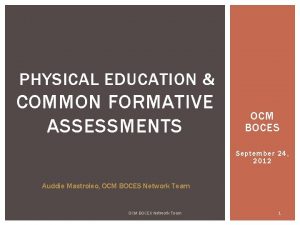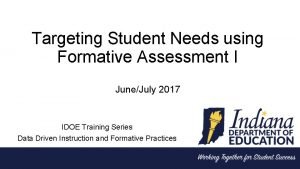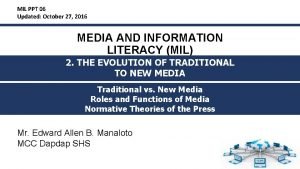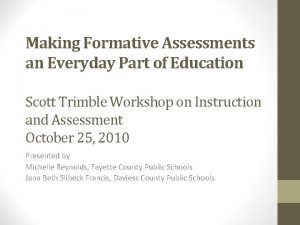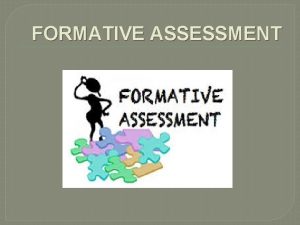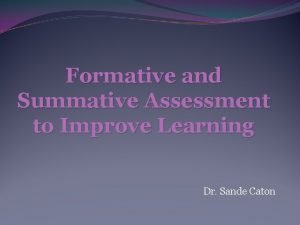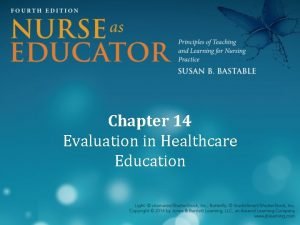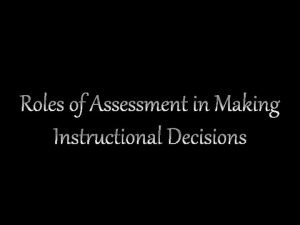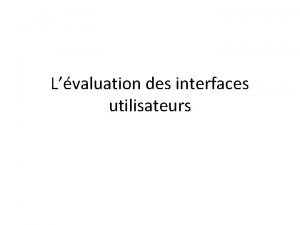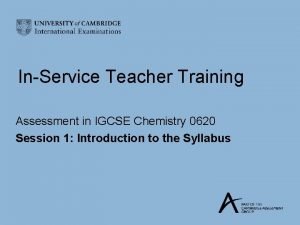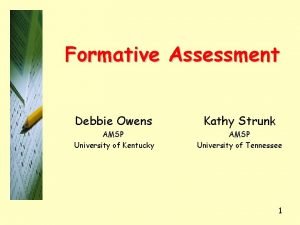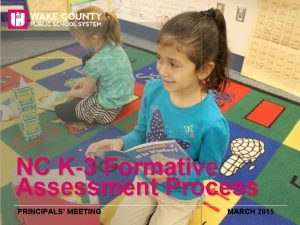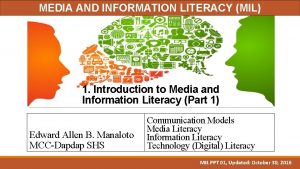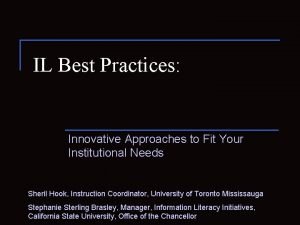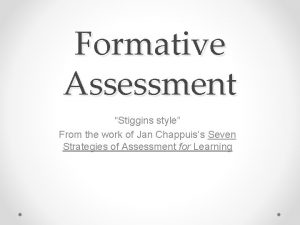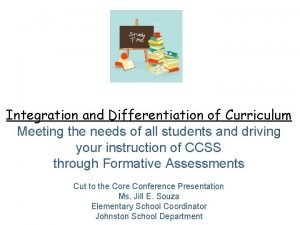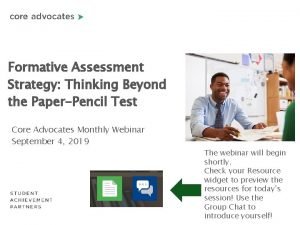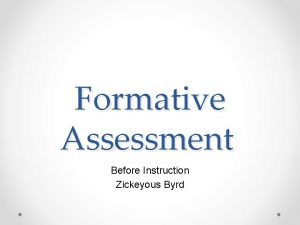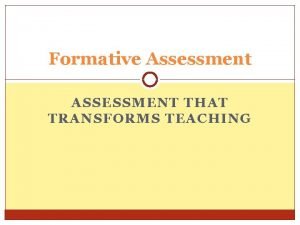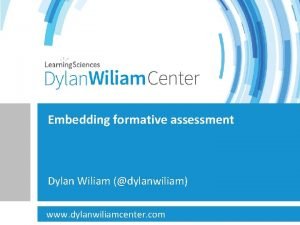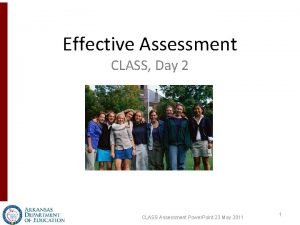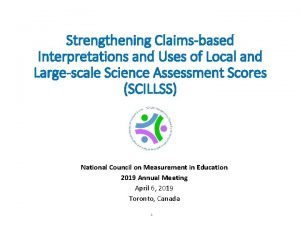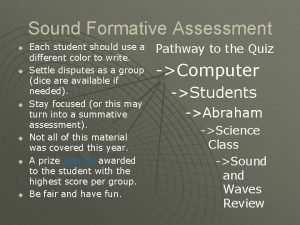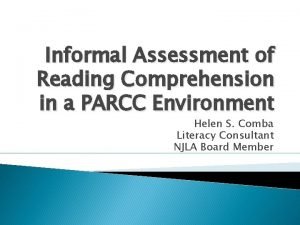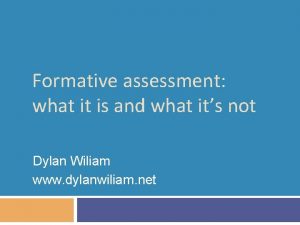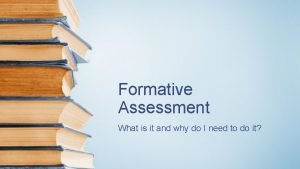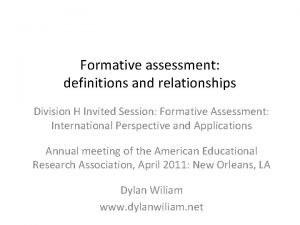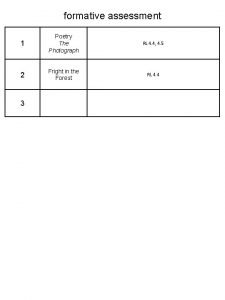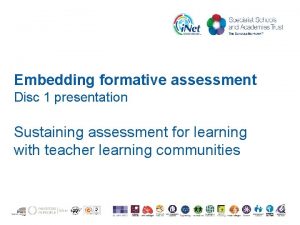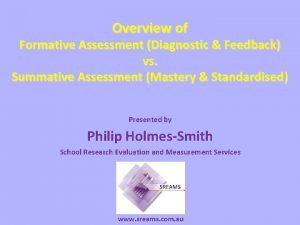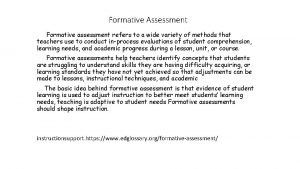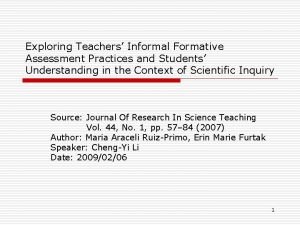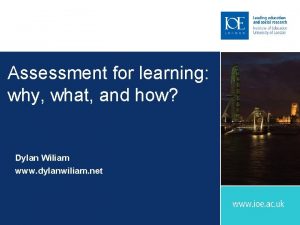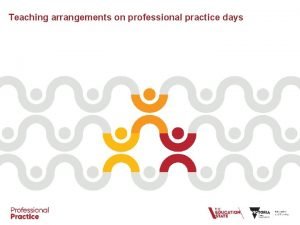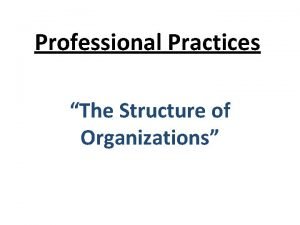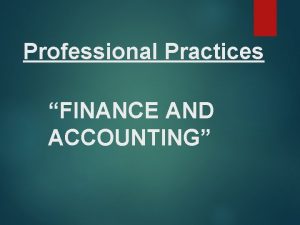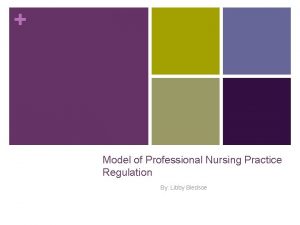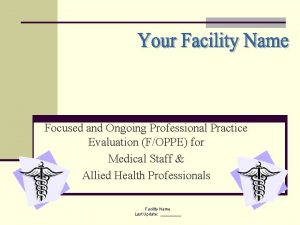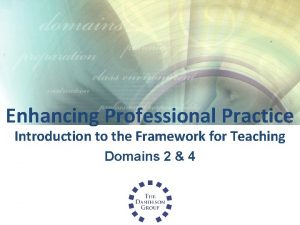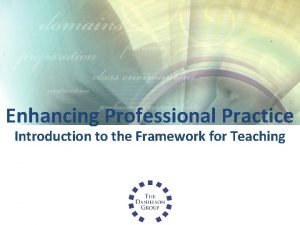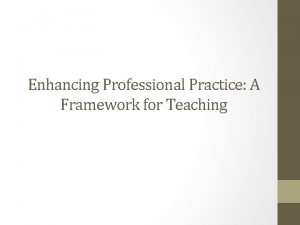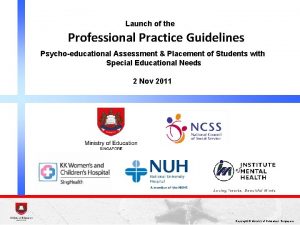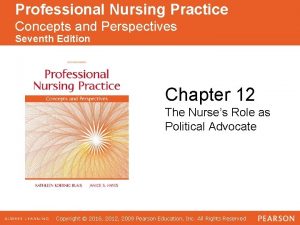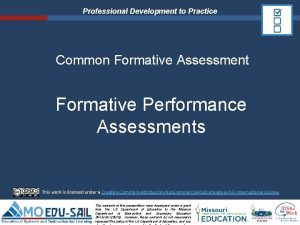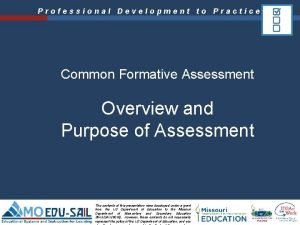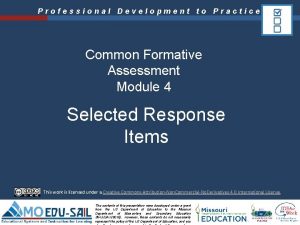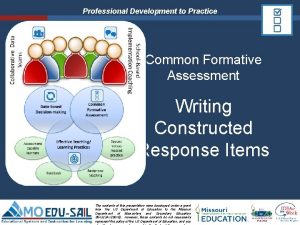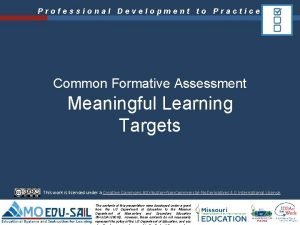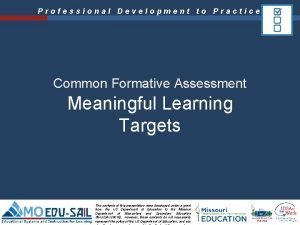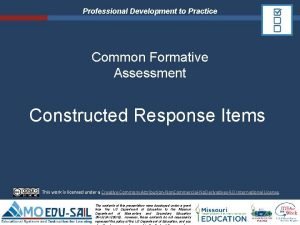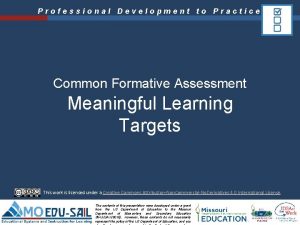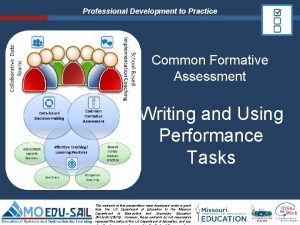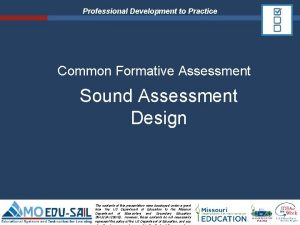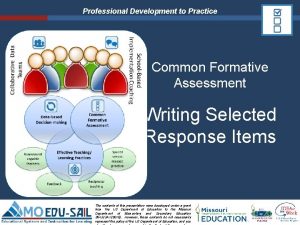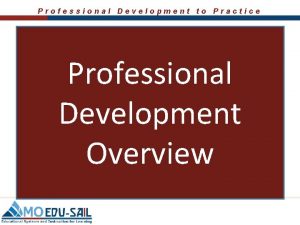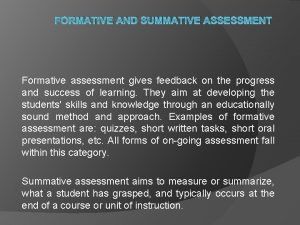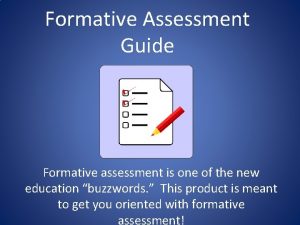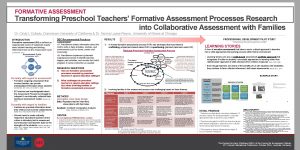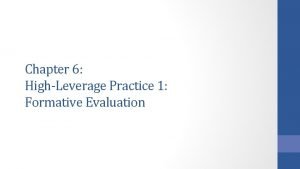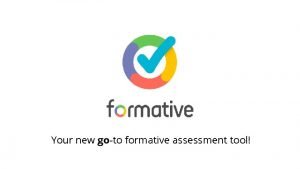Professional Development to Practice Common Formative Assessment Overview
























































- Slides: 56

Professional Development to Practice Common Formative Assessment Overview and Purpose of Assessment This work is licensed under a Creative Commons Attribution-Non. Commercial-No. Derivatives 4. 0 International License. The contents of this presentation were developed under a grant from the US Department of Education to the Missouri Department of Elementary and Secondary Education (#H 323 A 120018). However, these contents do not necessarily represent the policy of the US Department of Education, and you

Professional Development to Practice Acknowledgements Special thanks to all contributors to the development and revision of this module. The original collection of learning packages was rolled-out for use by Regional Professional Development Center (RPDC) Consultants in July 2013 after being developed by a team of content experts. The collection of learning packages was developed through efforts funded by the Missouri State Personnel Development Grant (SPDG). The following individual/groups are thanked immensely for their hard work in developing this package. -------------------------------------------------------------------Content Development and Revision Support UMKC Institute for Human Development Ronda Jenson, Director Stefanie Lindsay Arden Day Carla Williams Jodi Arnold SPDG Management Team The contents of this presentation were developed under a grant from the US Department of Education to the Missouri Department of Elementary and Secondary Education (#H 323 A 120018). However, these contents do not necessarily represent the policy of the US Department of Education, and you

Professional Development to Practice Initial Content Development Team, 2013 Rob Gordon, Team Leader, MO PLC Alan Bancroft, C RPDC Debra Cole, St. L, RPDC Cheri Fuemmeler, SE RPDC Jane Jackson, NW RPDC Melanie Whitener Needling, SE RPDC Linda Null, SE RPDC Rebecca Rider, SE RPDC Kelley Ritter, SW RPDC Jay Roth, SW, RPDC Jana Scott, HOM, RPDC Thea Scott, DESE Alicia Wilson, KC RPDC 2016 Revision Team Nancy Steele, Facilitator, NE SIS Pam Carte, NE RPDC Beverly Colombo, St. L, RPDC Liz Condray, SC RPDC Janet Crafton, SC RPDC Ginger Henry, DESE Rebecca Rider, SE RPDC Sarah Spence, C SIS The contents of this presentation were developed under a grant from the US Department of Education to the Missouri Department of Elementary and Secondary Education (#H 323 A 120018). However, these contents do not necessarily represent the policy of the US Department of Education, and you

Professional Development to Practice Welcome and Introductions Please take a moment to introduce (or reintroduce) yourself to the group, by telling your name, district, and position. Our trainers for the day are….

Professional Development to Practice

Professional Development to Practice Collaborative Work Foundations e nts z i e l i t m – u sess A F C lity as to ive t a r e o ativ llab Qua edback hing & 1. Co mon Form fe ac m e s o t a C. e 2 ent rov sion i m p c s s e e m for D. i d g a e t Ass n s i da rn -Ba nt a a e t e z a e i l l D m i 3. ove out – ut r p g M n i BD ous im ue ab Mak D tinu ialog ng eam ve t n o e z c d i ro til ni h p r u g a m – i u e CT thro ing & l es to ning. s s e ach proc g & lear e t in teach as e r A s 3 Key Team

Professional Development to Practice Common Formative Assessment Modules 1 -3 üO w e i v r ve l u f g nin a e üM ing n Lear ts e g r a T d n u o t n üS e m s s e Ass n g i s e D

Professional Development to Practice

Professional Development to Practice Missouri Teacher Standards q. Common formative assessments address the following Missouri Teacher Standards: q. Standard #7: Student Assessment and Data Analysis q. Standard #2: Student Learning, Growth and Development q. Standard #4: Critical Thinking q. Standard #9: Professional Collaboration (Missouri Department of Elementary and Secondary Education, 2013)

Professional Development to Practice Learner Objectives of the Common Formative Assessment Modules 1. Understand the clear purposes of assessment by clarifying q Why they are assessing q Who will use the results of assessment data q What they will do with the assessment data 2. Develop clear and meaningful learning targets to guide instruction and student learning 3. Construct quality assessment instruments which are of sound design and measure the learning targets

Professional Development to Practice Module #1: Common Formative Assessment Overview and Purpose of Assessment Guiding Questions q. What is the difference between assessment OF learning and assessment FOR learning? q. What assessments are we currently doing? q. Who are the users of assessment results? q. For assessment instruments to have their greatest leverage, what function should they have?

Professional Development to Practice Norms q. Start and end on time q. Be an engaged participant q. Be an active listener – open to new ideas q. Use electronics respectfully

Professional Development to Practice SWAP MEET! • Ch r • I sp is • I b end ab elie ve t out… hat … On an index card write the following: q. Your name & area (grade, content, etc. ) q. Percentage of your professional time you spend assessing students q. A belief you have about the role of assessment

Professional Development to Practice SWAP MEET! • Ch r • I sp is • I b end ab elie ve t out… hat … q. Stand swap cards with someone at a different table q. Inquire about the author’s belief – if needed, record why it’s important q. After sharing, find another person and represent the first person with whom you spoke q. Return to your groups & explore any themes

Professional Development to Practice Large group processing What similarities and themes emerged at your table groups?

Professional Development to Practice Ways We Already Assess The contents of this presentation were developed under a grant from the US Department of Education to the Missouri Department of Elementary and Secondary Education (#H 323 A 120018). However, these contents do not necessarily represent the policy of the US Department of Education, and you

Professional Development to Practice At Your Table: q Label a piece of chart paper, “Ways we assess now” q List all of the ways that you currently assess. Be specific. Ways we assess now

Professional Development to Practice At your table: q Code (highlight or underline) to indicate how labor intensive each is for teachers… q. Red for high Ways we assess now q. Blue for medium q. Green for low

Professional Development to Practice Who are the primary user(s) of the information from each assessment? Now code with the following: A=Administration / T=Teacher S=Student / P=Parent Consider: What does the assessment tell that user? How do they use the information?

Professional Development to Practice Here’s What, So What, Now What Using the three-column work sheet q. Here’s What: Record specific data generated. q. So What: Draw conclusions from the data. q. Now What: List some implications this has for teachers and students.

Professional Development to Practice Let’s Share!

Professional Development to Practice

Professional Development to Practice Forms of Assessment External Assessment Ranks & Sorts State/Federal Accountability (Heritage, 2010)

Professional Development to Practice Forms of Assessment District-Level Assessment External Assessment Benchmark(s) of Proficiency and Mastery Ranks & Sorts State/Federal Accountability (Heritage, 2010)

Professional Development to Practice Forms of Assessment District-Level Assessment External Assessment Benchmark(s) of Proficiency and Mastery Ranks & Sorts State/Federal Accountability AFTER THE LEARNING (Heritage, 2010)

Professional Development to Practice Forms of Assessment Common Assessments formative | summative District-Level Assessment External Assessment Collaboratively Developed; Collectively Scored and Analyzed Benchmark(s) of Proficiency and Mastery Ranks & Sorts State/Federal Accountability AFTER THE LEARNING (Heritage, 2010)

Professional Development to Practice Forms of Assessment Classroom Assessment Common Assessments formative | summative District-Level Assessment External Assessment High-quality instruction Collaboratively Developed; Collectively Scored and Analyzed Benchmark(s) of Proficiency and Mastery Ranks & Sorts Ongoing Student/ Teacher interaction State/Federal Accountability AFTER THE LEARNING (Heritage, 2010)

Professional Development to Practice Forms of Assessment Classroom Assessment Common Assessments formative | summative District-Level Assessment External Assessment High-quality instruction Collaboratively Developed; Collectively Scored and Analyzed Benchmark(s) of Proficiency and Mastery Ranks & Sorts Ongoing Student/ Teacher interaction DURING THE LEARNING State/Federal Accountability AFTER THE LEARNING (Heritage, 2010)

Professional Development to Practice Forms of Assessment Classroom Assessment Common Assessments formative | summative District-Level Assessment External Assessment High-quality instruction Collaboratively Developed; Collectively Scored and Analyzed Benchmark(s) of Proficiency and Mastery Ranks & Sorts Ongoing Student/ Teacher interaction State/Federal Accountability Pyramid Response to Interventions DURING THE LEARNING AFTER THE LEARNING (Du. Four, Eaker, & Karhanek, 2010) (Heritage, 2010)

Professional Development to Practice Forms of Assessment Classroom Assessment Common Assessments formative | summative District-Level Assessment External Assessment High-quality instruction Collaboratively Developed; Collectively Scored and Analyzed Benchmark(s) of Proficiency and Mastery Ranks & Sorts Ongoing Student/ Teacher interaction Pyramid Response to Interventions DURING THE LEARNING Daily State/Federal Accountability Weekly Most Formative AFTER THE LEARNING Biweekly More Formative Monthly Quarterly Semester Annually More Summative Most Summative HIGHEST LEVERAGE PRACTICES …………………………… LOWEST LEVERAGE PRACTICES (Du. Four, Eaker, & Karhanek, 2010) (Heritage, 2010) (Reeves, 2002)

Professional Development to Practice Inside the Black Box: Raising Standards Through Classroom Assessment “All those activities undertaken by teachers that provide information to be used as feedback – and by their students in assessing themselves – to modify teaching and learning activities. ” Available http: //www. kappanmagazine. org/content/92/1/81. abstract (Black & Wiliam, 1998)

Professional Development to Practice Common Formative Assessment Defined Common: Given by all teachers at a grade level or in a content area Formative: Provides data to inform planning and instruction Assessment: Provides analytical rather than evaluative information. (Cook & Negron, 2009)

Professional Development to Practice Metaphor With a partner, complete the following prompt, Effective assessment is like a(n) ________ because _________.

Professional Development to Practice KEYS TO QUALITY ASSESSMENT The contents of this presentation were developed under a grant from the US Department of Education, #H 323 A 120018. However, these contents do not necessarily represent the policy of the US Department of Education, and you should not assume endorsement by the Federal

Accurate Assessment WHY ASSESS? What’s the purpose? Who will use the results? (Stiggins, Arter, Chappuis, J. , & Chappuis, S. , 2004)

Accurate Assessment WHY ASSESS? What’s the purpose? Who will use the results? ASSESS WHAT? What are the learning targets? Are they clear? Are they good? (Stiggins, et al. , 2004)

Accurate Assessment ASSESS WHAT? What are the learning targets? Are they clear? Are they good? WHY ASSESS? What’s the purpose? Who will use the results? ASSESS HOW? What method? Written well? Sampled how? Avoid bias how? (Stiggins, et al. , 2004)

Effectively Used COMMUNICATE HOW? How is information managed? reported? (Stiggins, et al. , 2004)

Accurate Assessment ASSESS WHAT? What are the learning targets? Are they clear? Are they good? WHY ASSESS? What’s the purpose? Who will use the results? ASSESS HOW? What method? Written well? Sampled how? Avoid bias how? COMMUNICATE HOW? How is information managed? reported? Effectively Used (Stiggins, et al. , 2004)

Accurate Assessment ASSESS WHAT? What are the learning targets? Are they clear? Are they good? WHY ASSESS? What’s the purpose? Who will use the results? ASSESS HOW? What method? Written well? Sampled how? Avoid bias how? Effectively Used COMMUNICATE HOW? How is information managed? reported? (Stiggins, et al. , 2004)

Accurate Assessment ASSESS WHAT? What are the learning targets? Are they clear? Are they good? WHY ASSESS? What’s the purpose? Who will use the results? ASSESS HOW? What method? Written well? Sampled how? Avoid bias how? Students are users too! Be sure students understand targets too! Students track progress and communication, too! Students can participate in the process too! Effectively Used COMMUNICATE HOW? How is information managed? reported? (Stiggins, et al. , 2004)

Accurate Assessment WHY ASSESS? What’s the purpose? Who will use the results? Students are users too! This is what is charted in “Ways We Assess Now” (Stiggins, et al. , 2004)

Professional Development to Practice Comparing Assessment of learning and Assessment for Learning OF The contents of this presentation were developed under a grant from the US Department of Education to the Missouri Department of Elementary and Secondary Education (#H 323 A 120018). However, these contents do not necessarily represent the policy of the US Department of Education, and you FOR

Professional Development to Practice “Because the same assessment can be used both formatively and summatively, terms formative and summative make much more sense as descriptions of the function that assessment data serve, rather than of the assessment instruments themselves. ” (Black & Wiliam, 1998)

Professional Development to Practice Focused Read q. Individually read, “Formative or Summative Assessment? ” q. Code with: Affirms prior knowledge Surprised you You wish to know more about this q. In groups of 3 or 4, share a or a (Chappuis, 2009)

Professional Development to Practice QUIZ TIME! (a formative assessment) Is the use formative or summative?

Professional Development to Practice Forms of Assessment Classroom Assessment Common Assessments formative | summative District-Level Assessment External Assessment High-quality instruction Collaboratively Developed; Collectively Scored and Analyzed Benchmark(s) of Proficiency and Mastery Ranks & Sorts Ongoing Student/ Teacher interaction State/Federal Accountability Pyramid Response to Interventions DURING THE LEARNING AFTER THE LEARNING Assessment FOR …………………. OF Learning Du. Four, Eaker, & Karhanek, 2010) (Heritage, 2010) (Reeves, 2002)

Professional Development to Practice “Assessment is not something that is done to students separate and apart from instruction; assessment must be – must be seen to be – something that is done with students as an integral part of the learning process. ” (O’Connor, 2002)

Professional Development to Practice As we conclude… Guiding Questions: q. What is the difference between assessment OF learning and assessment FOR learning? q. What assessments are we currently doing? q. Who are the users of assessment results? q. For assessment instruments to have their greatest leverage, what function should they have?

Professional Development to Practice M. I. P. What is your “Most Important Point” (M. I. P. ) from the morning?

Professional Development to Practice M. I. P. What is your “Most Important Point” (M. I. P. ) from the training? • Chr i • I sp s e • I be nd abou lieve t… that … Locate your “Swap Meet” partner & have a standing conversation!

Professional Development to Practice CLOSING & Follow-up Common Formative Assessment Overview and Purpose of Assessment The contents of this presentation were developed under a grant from the US Department of Education to the Missouri Department of Elementary and Secondary Education (#H 323 A 120018). However, these contents do not necessarily represent the policy of the US Department of Education, and you

Professional Development to Practice Profile 58

Professional Development to Practice Self-Assessment Practice Profile Excel Workbook http: //sapp. missouripd. org

Professional Development to Practice Next Steps: Action = Results What steps will you take to start implementing?

Professional Development to Practice Contact Information Please contact me to schedule follow-up coaching and/or additional professional development.
 Formative assessments in physical education
Formative assessments in physical education Common core institute
Common core institute Formative assessment process
Formative assessment process Mil ppt
Mil ppt Venn diagram of media and information literacy
Venn diagram of media and information literacy People in media and people as media
People in media and people as media Scott trimble workshop
Scott trimble workshop Summative and formative assessment
Summative and formative assessment Formative evaluation
Formative evaluation Facets of formative assessment
Facets of formative assessment Rsa evaluation model
Rsa evaluation model Is diagnostic assessment formative or summative
Is diagnostic assessment formative or summative What is summative evaluation in hci
What is summative evaluation in hci Igcse teacher training pack
Igcse teacher training pack Round robin charts formative assessment
Round robin charts formative assessment Formative assessment
Formative assessment Ritual or expressive model of communication
Ritual or expressive model of communication Formative assessment is tasting the soup while cooking
Formative assessment is tasting the soup while cooking Formative style
Formative style Formative assessment
Formative assessment Examples of formative assessment
Examples of formative assessment Examples of formative assessment
Examples of formative assessment Formative assessment
Formative assessment Summative and formative assessment
Summative and formative assessment Dylan williams formative assessment
Dylan williams formative assessment Examples of formative assessment
Examples of formative assessment Difference between objective and subjective
Difference between objective and subjective Diagnostic assessment examples
Diagnostic assessment examples Formative assessment
Formative assessment Formative assessment
Formative assessment Formative assessment
Formative assessment Formative assessment
Formative assessment Formative assessment meaning
Formative assessment meaning Formative assessment for poetry
Formative assessment for poetry Formative assessment
Formative assessment Formative assessment marks
Formative assessment marks Assessment formative summative diagnostic
Assessment formative summative diagnostic Assessment refers to
Assessment refers to Informal formative assessment
Informal formative assessment Dylan wiliam leadership for teacher learning
Dylan wiliam leadership for teacher learning Professional practice days
Professional practice days Structure of organization in professional practice
Structure of organization in professional practice Finance and accounting in professional practice
Finance and accounting in professional practice Professional nursing practice: concepts and perspectives
Professional nursing practice: concepts and perspectives Professional business practice
Professional business practice Model of professional nursing practice regulation
Model of professional nursing practice regulation Focused professional practice evaluation
Focused professional practice evaluation Enhancing professional practice
Enhancing professional practice Enhancing professional practice
Enhancing professional practice Tpess
Tpess Enhancing professional practice: a framework for teaching
Enhancing professional practice: a framework for teaching Moe professional practice guidelines
Moe professional practice guidelines Political astuteness in nursing
Political astuteness in nursing It is to conform to accepted professional practice
It is to conform to accepted professional practice Factors and multiples of 42
Factors and multiples of 42 Common anode and common cathode
Common anode and common cathode Factor tree for 72
Factor tree for 72
